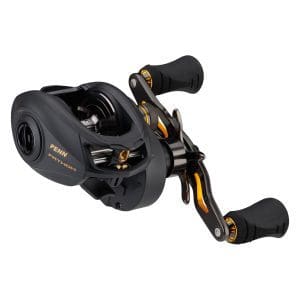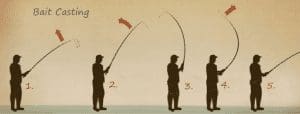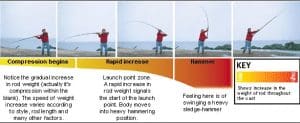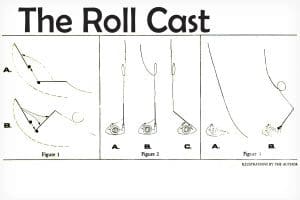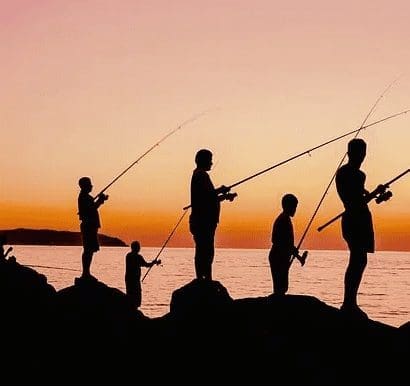
Imagine you’re out by the water, ready to catch some fish with your fishing rod. You’ve probably heard about something called “casting techniques.” So, what are these casting techniques, and why are they so important for us, anglers?
Casting techniques are like the secret moves in a video game. They’re the special skills we use to throw our bait or lures exactly where we want them to go in the water. These skills are super important because they can make the difference between a day of catching lots of fish or going home with an empty hook.
Contents
Essential Gear for Casting Success with a Rod.🐟
Let’s get down to the essentials for casting techniques in fishing with a rod. We’ll break it all down while keeping things simple and clear.
Picking the Right Rod and Reel
Imagine your fishing rod and reel as your trusty fishing partners. First things first, what’s the deal with casting rods vs. spinning rods?
Casting Rods
A casting rod is like your precision tool for specific casting techniques. It’s great for when you need accuracy and power, especially when paired with a baitcasting reel. Use this combo for techniques like flipping, pitching, and precise casting fishing into tight spots.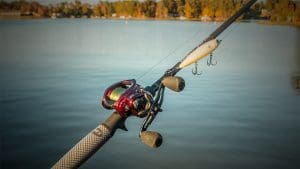
Spinning Rods
On the other hand, a spinning rod pairs up with a spinning reel. It’s your go-to for techniques that require long-distance casting or when you’re working with lighter lures. It’s also beginner-friendly.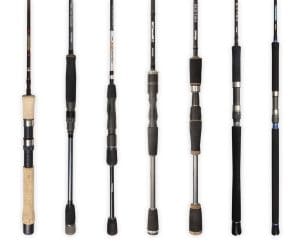
Reels: Making the Right Choice
Your reel is where the real action happens—it controls the line and, ultimately, your lure. When choosing a reel for your casting fishing adventure, consider these:
- Baitcasting Reels: These are great for casting rods when you need pinpoint accuracy and control. They shine in techniques like casting fishing in tight spots or reeling in big fish.

- Spinning Reels: Match these with spinning rods for long casts and finesse techniques. They’re user-friendly, making them perfect for beginners.
The Importance of Line and Lures
Now, let’s focus on your fishing line and lures. You might wonder, why are they so important?
The Line Story
Your fishing line is crucial. There are different types—monofilament, fluorocarbon, and braided lines—each with its perks. Monofilament is versatile, fluorocarbon is hard to see underwater, and braided lines are strong and sensitive.
Lures: Tempting the Fish
Lures are like candy for fish. Choosing the right one matters. Depending on your technique and the type of fish you’re after, you’ll want to pick the perfect lure. Soft plastics, crankbaits, and jigs are a few options.
Fundamentals of Casting.🐟
Let’s dive into the fundamentals of casting, a crucial skill when it comes to fishing with a rod. In this section, we’ll cover everything from the right stance to nifty tricks for beginners, all while keeping an eye on our keywords for Google’s attention.
The Right Stance for Effective Casting
To kick things off, let’s talk about the position. What’s the key to an effective cast?
Picture yourself on a serene night by the water, stars reflecting off its surface. You stand tall with your feet shoulder-width apart, your body turned slightly to the side. This balanced stance helps you cast with precision and avoid toppling over.
Handling the Rod Like a Pro
Now, let’s address a common question: can a casting rod be used with a spinning reel?
Absolutely, but you’ll want to make sure you’re using the right gear. A casting rod is typically designed for baitcasting reels, while a spinning rod pairs up with a spinning reel. It’s like matching puzzle pieces – they work best together.
When you grip the rod, do it with finesse. Imagine you’re shaking hands with an old friend. Your fingers should wrap gently around the handle, not in a death grip. This allows for flexibility and better control.
Mastering Basic Casting Techniques
For aspiring anglers, here are some basic casting techniques you should master:
The Overhead Cast
This one’s a classic. With your rod pointed upwards, use a smooth, controlled motion to send your bait flying. Think of it as if you’re tossing a ball overhead.
The Sidearm Cast
Perfect for those spots where overhanging branches threaten to snag your line. Hold your rod parallel to the water, and swing it to the side like a pendulum.
The Pitch Cast
When you need to be sneaky and drop your bait precisely where the fish are lurking, the pitch cast is your friend. Lower your rod tip and gently swing it forward to drop your lure with finesse.
Common Casting Techniques.🐟
In this section, we’ll delve into the art of casting fishing and explore various casting techniques. Whether you’re a seasoned angler or just starting out, understanding these techniques is essential for a successful day on the water. Plus, we’ll answer some common questions like how to cast a fishing rod with a spinning reel and how to cast a fishing rod for beginners.
Casting with Bait
When it comes to casting with bait, the overhead cast is your go-to move. Here’s how it’s done:
- Hold your rod with a relaxed grip, ensuring your reel is engaged.
- With your rod tip pointing upwards, bring it behind you, creating a smooth, controlled motion.
- As you swing the rod forward, release the line with your thumb (if using a baitcasting reel) or open the bail (if using a spinning reel).
- The bait should soar through the air and land where you aim, hopefully attracting a hungry fish.

Casting with Lures
When using lures, precision is key. Try the following technique for accurate casting:
- Hold your rod parallel to the water’s surface, with your casting hand’s palm facing up.
- Use a sidearm motion, swinging the rod to the side and then forward.
- Release the line at the right moment for your lure to land gracefully in the target zone.
Fly Casting
Fly fishing is a unique art that requires a distinct casting technique. Here’s a simplified overview:
- Begin with a basic overhead cast. However, instead of releasing the line, pause and let it unfurl behind you.
- When you’re ready to cast, use a flick of the wrist to send the line forward.
- The goal is to have the fly gently land on the water’s surface, mimicking the appearance of natural insects and enticing fish to strike.
Advanced Casting Techniques.🐟
In this section, we’ll delve into advanced casting techniques that can take your fishing rod skills to the next level. Whether you’re familiar with casting fishing or just curious about what is a casting rod used for, you’re in for a treat. We’ll also explore some uncommon casting the line methods for those looking to push the boundaries of their angling prowess.
Exploring Advanced Casting Techniques
When you’re ready to up your game, consider these advanced fishing rod techniques:
1. The Pendulum Cast
Imagine swinging your fishing rod like a pendulum on a grandfather clock. This technique is perfect for achieving remarkable casting distances. Here’s how:
- Stand with your feet shoulder-width apart and your body turned slightly to the side.
- With the rod tip pointing down and the line hanging loosely, swing the rod in a pendulum motion.
- Release the line at the precise moment when it swings forward for maximum distance.

2. The Roll Cast
Ideal for casting in areas with limited backcasting space, the roll cast is a valuable skill. Here’s how to master it:
- Start with your rod tip close to the water’s surface and the line trailing behind.
- Sweep the rod in a smooth, semi-circular motion, creating a roll that propels the line forward.
- This technique is especially handy when dealing with obstacles like trees or bushes.

Mastering Long-Distance Casting
When it comes to casting fishing, long-distance casting can be a game-changer. Here are some tips to help you master it:
- Choose the right gear: Opt for a longer casting rod and a low-profile baitcasting reel designed for long casts.
- Practice your timing: Timing is everything when it comes to achieving distance. Work on your casting stroke and release point to maximize your cast’s potential.
- Control your line: Keep your line spooled evenly on the reel to reduce friction and improve casting distance.
Casting in Moving Water
When casting in waters with currents, it’s essential to consider a few factors:
- Adjust your angle: Position yourself at an angle to the current so that it doesn’t carry away your bait or lure too quickly.
- Use heavier lures or sinkers: Heavier lures or sinkers can help your bait reach the desired depth despite the current’s pull.
Practice patience: It may take time to develop the feel for casting in moving water, so be patient and persistent.
Tips to Enhance Your Casting Skills🐟
In this section, we’re diving into some practical advice that can help you fine-tune your casting techniques and elevate your angling game. Whether you’re pondering questions like can a casting rod be used with a spinning reel or looking to explore spin casting techniques, these insights will be your guide.
Practical Tips for Perfecting Your Casting Techniques
Here are some actionable tips to enhance your casting skills:
1. Practice Makes Perfect
Just like any skill, practice is essential. Dedicate time to practice your casting techniques regularly. Try different types of casts and vary your bait or lures to gain versatility.
2. Focus on Timing
Timing is crucial in casting. Work on the timing of your release and the power of your cast. A well-timed release can significantly improve accuracy and distance.
3. Experiment with Different Lures
Different lures behave differently in the water. Experiment with a variety of lures to understand how they cast and retrieve. This knowledge will help you adapt to different fishing situations.
4. Seek Feedback
Don’t be shy about seeking feedback from experienced anglers or joining a fishing community. They can provide valuable insights and tips to improve your casting techniques.
Practicing and Polishing Your Skills Off the Water
You don’t always have to be on the water to improve your casting skills. Here are some ways to practice and polish your skills even when you’re not fishing:
1. Backyard Practice
Set up a target in your backyard or an open area and practice your casting techniques. This can help you refine your accuracy and get a feel for your gear.
2. Visualization
Mentally rehearse your casting techniques. Close your eyes and visualize the perfect cast, focusing on every detail. Visualization can improve muscle memory and overall casting proficiency.
3. Watch Tutorials
There are plenty of video tutorials and online resources that offer valuable insights into casting techniques. Spend time watching and learning from experts.

Resources and Courses for Skill Enhancement
If you’re dedicated to honing your casting skills, consider these resources and courses:
1. Local Workshops
Look for local fishing workshops or classes where you can receive hands-on instruction and guidance from experienced anglers.
2. Online Courses
Many online courses cover various aspects of fishing, including casting techniques. These courses often include video lessons, quizzes, and interactive learning.
3. Fishing Clubs
Joining a fishing club or association can provide access to experienced mentors and opportunities to participate in casting tournaments or events.

